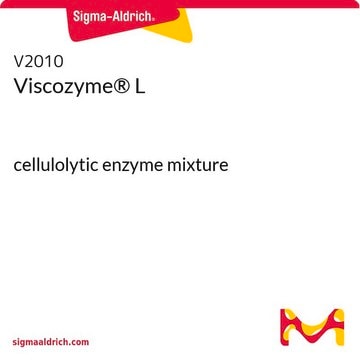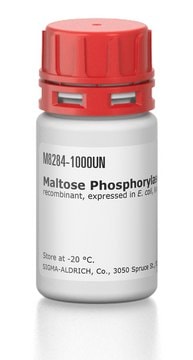This product is provided as a slurry containing 10 mg of enzyme in saturated ammonium sulfate precipitate. It is supplied at 100 units, with a concentration of 0.13 units per 1 mg of protein at 10 mg per ml.
Kluczowe dokumenty
E6412
Cellobiohydrolase I from Hypocrea jecorina
0.13 U/mg, recombinant, expressed in corn
Synonim(y):
Cel7A, Cellobiosidase, Cellulase
Wybierz wielkość
857,00 zł
Wybierz wielkość
About This Item
857,00 zł
Polecane produkty
rekombinowane
expressed in corn
Formularz
liquid
aktywność właściwa
0.13 U/mg
charakterystyka ekologicznej alternatywy
Design for Energy Efficiency
Learn more about the Principles of Green Chemistry.
sustainability
Greener Alternative Product
kategoria ekologicznej alternatywy
Warunki transportu
dry ice
temp. przechowywania
−20°C
Powiązane kategorie
Opis ogólny
Zastosowanie
Działania biochem./fizjol.
Definicja jednostki
Postać fizyczna
Hasło ostrzegawcze
Danger
Zwroty wskazujące rodzaj zagrożenia
Zwroty wskazujące środki ostrożności
Klasyfikacja zagrożeń
Resp. Sens. 1
Kod klasy składowania
10 - Combustible liquids
Klasa zagrożenia wodnego (WGK)
WGK 3
Temperatura zapłonu (°F)
Not applicable
Temperatura zapłonu (°C)
Not applicable
Wybierz jedną z najnowszych wersji:
Certyfikaty analizy (CoA)
Nie widzisz odpowiedniej wersji?
Jeśli potrzebujesz konkretnej wersji, możesz wyszukać konkretny certyfikat według numeru partii lub serii.
Masz już ten produkt?
Dokumenty związane z niedawno zakupionymi produktami zostały zamieszczone w Bibliotece dokumentów.
Klienci oglądali również te produkty
Produkty
Uncover more about glycosaminoglycans and proteoglycans including the structure of glycosaminoglycans (GAGs), the different types of GAGs, and their functions.
Dowiedz się więcej o glikozoaminoglikanach i proteoglikanach, w tym o strukturze glikozoaminoglikanów (GAG), różnych typach GAG i ich funkcjach.
-
Good morning. This material is liquid. Could you tell me the volume that comes in the bottle?
1 answer-
Helpful?
-
Active Filters
Nasz zespół naukowców ma doświadczenie we wszystkich obszarach badań, w tym w naukach przyrodniczych, materiałoznawstwie, syntezie chemicznej, chromatografii, analityce i wielu innych dziedzinach.
Skontaktuj się z zespołem ds. pomocy technicznej











